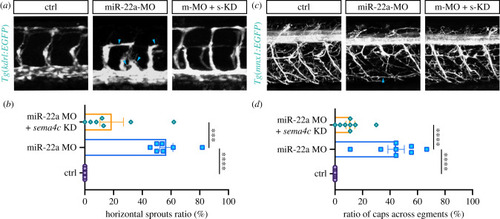- Title
-
MicroRNA-22 coordinates vascular and motor neuronal pathfinding via sema4 during zebrafish development
- Authors
- Sheng, J., Gong, J., Shi, Y., Wang, X., Liu, D.
- Source
- Full text @ Open Biol.
|
Deficiency of miR-22a caused aberrant vascular networks. ( |
|
miR-22a regulates ISV tip cell behaviour. ( |
|
Deficiency of mir-22a caused aberrant axonal projection of PMNs. ( EXPRESSION / LABELING:
PHENOTYPE:
|
|
miR-22a regulates primary motor neuron and ISV pathfinding. ( |
|
miR-22a directly targets |
|
Reducing EXPRESSION / LABELING:
PHENOTYPE:
|
|
Endothelial miR-c22a regulates PMNs axonal navigation. ( EXPRESSION / LABELING:
PHENOTYPE:
|







